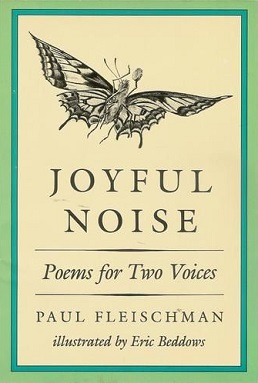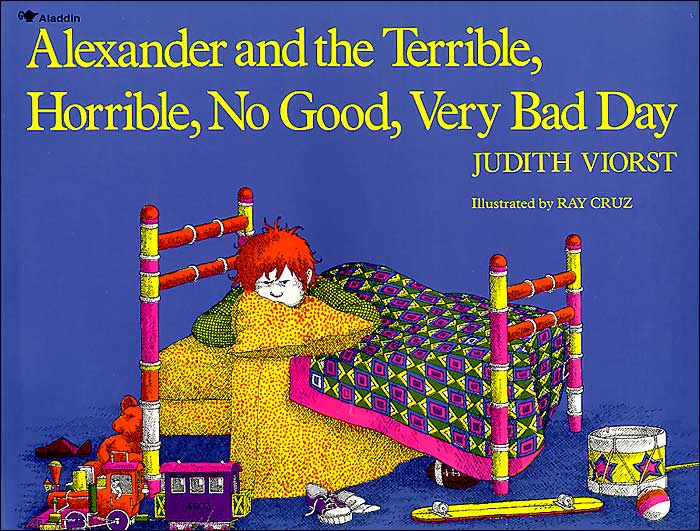
FIGGIE HOBBIN is a collection of 13 children's poems written by Charles Causley and complimented with delicate line drawings of Trina Schart Hyman. I enjoyed the delightful random nonsense of many of the poems contrasted with the thought provoking introspect of others. Starting with I Saw a Jolly Hunter with its suprising ending each poem has a life all its own. The last poem in the book is the one from which the book gets its title. It speaks of the old King of Cornwell, tempted with all sorts of exotic dishes, who petulantly tells his servants to take it all away and bring him what he really wants--a humble dish of Figgie Hobbin. - pudding sweetened with a handful of raisins (raisins being "figs" and figs "broad raisins"). A lot like me... when I find something on the menu I like, I'm not likely to try anything else.
Bonnie R
207 of 1001




_cover_art.jpg)










 The children in room 207 are misbehaving: spitballs and paper planes are everywhere and they are rude even during story hours! Poor miss Nelson cannot cope with them and disappears one day. Now the children from the room 207 have a new substitute teacher: Ms. Viola Swamp! She is strict, she is mean, and she will give so much homework to children from the room 207! Now children from room 207 miss Nelson very much…… This humorous book is a perfect read for preschoolers and up. With the plot worthy of Hitchcock, and with funny quirky illustration filled with clues and sharks, this marvelous story will delight, puzzle and amuse every child who loves to read silly stories-thrillers. The storyline is very creative, and the illustrations made with crayon complement the text perfectly. I loved the description of dailies in school with all the flying airplanes, chewing gum and noise sounded so familiar! The author also uses “speaking” last names such as detective Mc Smogg( who smokes pipes on the pictures) and Viola Swamp( mean and nasty one). I also enjoyed the concept of probability gently introduce when children try to figure out what happened to their beloved teacher (“Maybe Miss Nelson went to Mars” – “but that did not seem likely either”)
The children in room 207 are misbehaving: spitballs and paper planes are everywhere and they are rude even during story hours! Poor miss Nelson cannot cope with them and disappears one day. Now the children from the room 207 have a new substitute teacher: Ms. Viola Swamp! She is strict, she is mean, and she will give so much homework to children from the room 207! Now children from room 207 miss Nelson very much…… This humorous book is a perfect read for preschoolers and up. With the plot worthy of Hitchcock, and with funny quirky illustration filled with clues and sharks, this marvelous story will delight, puzzle and amuse every child who loves to read silly stories-thrillers. The storyline is very creative, and the illustrations made with crayon complement the text perfectly. I loved the description of dailies in school with all the flying airplanes, chewing gum and noise sounded so familiar! The author also uses “speaking” last names such as detective Mc Smogg( who smokes pipes on the pictures) and Viola Swamp( mean and nasty one). I also enjoyed the concept of probability gently introduce when children try to figure out what happened to their beloved teacher (“Maybe Miss Nelson went to Mars” – “but that did not seem likely either”)














 FREIGHT TRAIN by Donald Crews goes by about as fast a a freight train! We get a good look at the track and each part of the train, each with its own color and name described in font of the same color. Then it starts moving across the pages so quickly the colors smear and blur through various landscapes. Going, going, gone.....
FREIGHT TRAIN by Donald Crews goes by about as fast a a freight train! We get a good look at the track and each part of the train, each with its own color and name described in font of the same color. Then it starts moving across the pages so quickly the colors smear and blur through various landscapes. Going, going, gone.....




 OLD BEAR by Jane Hissey is an exciting search and rescue story involving the animals on the window sill in the play room. Bramwell Brown a younger bear, Duck who wished he could fly, the impulsive Rabbit, and Little Bear the youngest of all the toys remembered that, one of their own, Old Bear, had been put into protective storage long ago. Now that the children were older it would be safe for him to return but he had been forgotten, up in the attic. After several failed attempts, they came up with a plan that worked to rescue him and bring him back down to the play room. Beautifully illustrated, this is a warm story of friendship and reunion.
OLD BEAR by Jane Hissey is an exciting search and rescue story involving the animals on the window sill in the play room. Bramwell Brown a younger bear, Duck who wished he could fly, the impulsive Rabbit, and Little Bear the youngest of all the toys remembered that, one of their own, Old Bear, had been put into protective storage long ago. Now that the children were older it would be safe for him to return but he had been forgotten, up in the attic. After several failed attempts, they came up with a plan that worked to rescue him and bring him back down to the play room. Beautifully illustrated, this is a warm story of friendship and reunion.









